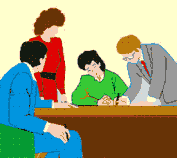|
Home Search Level 0 Level 1 Level 2 Level 3 Level 4 Level 4Pro Level 5 C/Sing Solo |
|
|
| Tech terms | Scales | Axioms | Drills | Checksheets | Processes | Prep. lists | C/S terms | C/S tool | Grades | Cramm | Points | KTW | Online | |
|
Home Search Level 0 Level 1 Level 2 Level 3 Level 4 Level 4Pro Level 5 C/Sing Solo |
|
|
| Tech terms | Scales | Axioms | Drills | Checksheets | Processes | Prep. lists | C/S terms | C/S tool | Grades | Cramm | Points | KTW | Online | |
More Scales
The CDEI Scale
The original scale was:4.0 Desire
1.5 Enforce
.5 Inhibit
It was expanded to:
Curiosity
Desire
Enforce
Inhibit
Unknown
Refused
These points, going down the scale, come about because of failure. Each lower
step 'explains' and justifies having failed with a higher level.
Example: Mr. M wants to get a pet dog. He goes to a pet shop and looks at many different dogs, all kept in cages. In other words - he is Curious. He sees one Dalmatian dog he falls for. He asks the store keeper, "How much is the Dalmatian?" The answer is "700 Dollars". That is more than Mr. M readily can spend on a pet dog. So he goes down the scale a bit and Desires the dog. He tries to argue with the store owner. He tries to Enforce himself to get the price down. The store owner won't give in. "The price is 700 Dollars - or no dog!" he tells the customer. Mr. M. finds, that is an Inhibiting price. He is frustrated and leaves. He tries to forget all about the Dalmatian. He is trying to make it Unknown to himself. When he comes home his son comes up to him and asks full of expectations, "Did you get a dog for us, Dad?" The Dad blows up in the face of his son and says, "There will be no pet dog, son. No way!" In other words he Refuses his son's request.
So you see in the example how each lower step on the scale comes about as a
failure on the previous step. This is not a full scale (like the tone scale from
- 40 to +40) but a sequence of attitudes that follow upon each other and can do
so at different levels on the tone scale.
Handling Upsets
The scales main use is to find the exact charge in dealing with breaks in ARC
(upsets, ARC breaks). Covered under 'How to Fly the Rudiments' in this Manual.
This scale is well suited to handling an upset with because it gives the principal attitudes we display in dealing with other people and terminals. The moment the pc realizes what was going on with himself in an ARC break situation things are a lot less complicated to confront. In not so many words, the pc realizes what he was doing in the situation - displaying an attitude. This can be taken to "an Earlier Similar ARC break" if it isn't fully resolved. By doing this, step-by-step, the pc frees up his attention from the enturbulation of the situation and surroundings. You see, his attention was fixated "over there" where all the action was. The auditor has directed the pc's attention away from all the complications in the situation that made the pc forget about himself and "loose his temper or cool". The pc realizes his own ARC in the situation (high or low) and is suddenly free to change his mind about the whole thing and laugh it off.
In the example with Mr. M the ARC break would probably happen when he got angry at his son. The wheeling and dealing with the store owner was more or less to be expected. He just couldn't deal with his son's great expectations on top of that. So the ARC break would be resolved when he realized he suddenly snapped and refused his son and their natural ARC.

REALITY AND COMMUNICATION
SCALE
The reality scale refers to the individual's hold on
reality and his agreement with others on what reality is. Reality breaks
are actually disagreements on reality, usually resulting only from a different
viewpoint and not from actual differences in reality itself. The communication
scale refers to the individual's ability to communicate with other people.
|
Reality |
Communication |
| Tone 4 | |
| Search for different
viewpoints and changes in reality -- complete flexibility in understanding, relating and evaluating different realities.
|
Ability to communicate
completely, withholding nothing; ability to create and construct through conversation. |
| Tone 3.5 | |
| Ability to understand,
relates and evaluate reality, regardless of change of difference in
viewpoint, moderate flexibility in realities brought to view without
eager search for new ones. |
Swift exchange of
deep-seated, deeply felt beliefs and ideas. |
| Attempts to reconcile own
reality with conflicting reality - limited flexibility.
|
Tentative expression of limited number of personal beliefs and ideas |
| Tone 3 | |
|
Awareness of possible validity |
Casual exchange of |
| Tone 2.5 | |
| Indifference to
conflicting reality -- "Maybe -- who cares?" attitude |
Indifference to communication of others -- "Let's not argue about it" attitude -- dismissal of communication if toward environment, not trying to get perceptics clear |
Refusal to match two
realities
|
Refusal to accept communication of |
| Tone 2 | |
|
Verbal doubt -- defense of own reality, attempts to undermine others
|
Indirect pot-shooting,
nagging, nasty cracks, invalidating other person or situation |
| Tone 1.5 | |
|
Destruction of opposing reality, wrecking or changing it, knocking out
props from other person's reality --
|
Shutting off other person's
|
| Doubt of opposing
reality, non-verbal disbelief, refusal to accept disbelief, refusal to accept conflicting reality without trying to fight back
|
Stubborn silence, sulking, refusal to communicate further, rejection of attempted communication by others |
| Tone 1 | |
| Doubt of own reality
-- insecurity; attempts to gain reassurance; if reality is environmental -- appeasement of gods or elements
|
Lying to avoid real
communication; can take the form of pretended agreement, flattery or verbal appeasements; or simply a false picture of person's feelings and ideas, false facade, artificial personality |
| Tone 0.5 | |
| Shame, anxiety, strong
doubt of own reality with consequent inability to act within it, must be
told what to do if person is to act at all, afraid to act
himself since he has no way to assess consequences |
Evasiveness to avoid
communication; hiding person's own thoughts and feelings; superficial
communication built on accepted standards without relation to person's real feelings; or schizoid real feelings; or schizoid |
| Complete withdrawal from
conflicting reality; refusal to test own reality against conflicting
one; locked in own rigid reality -- psychotic
|
Inability to communicate, completely unresponsive |
| Tone 0 | |
KNOW TO MYSTERY SCALE
Axiom 25:
Affinity is a scale of attitudes which falls away from the co-existence of static, through the interpositions of distance and energy, to create identity, down to close proximity but mystery.
By the practice of IS-NESS (Beingness) and NOT-IS NESS (refusal to Be) individuation progresses from the Knowingness of complete identification down through the introduction of more and more distance and less and less duplication, through Lookingness, Emotingness, Effortingness, Thinkingness, Symbolizingness, Eatingness, Sexingness, and so through to Not-Knowingness (Mystery). Until the point of Mystery is reached, some communication is possible, but even at Mystery an attempt to communicate continues. Here we have, in the case of an individual, a gradual falling away from the belief that one can assume a complete Affinity down to the conviction that all is a complete Mystery. Any individual is somewhere on this Know to-Mystery scale. The original Chart of Human Evaluation was the Emotion section of this scale.
This, then, is how the spirit assumes a beingness or identity. In terms of ARC, It belongs to A - affinity.
|
|
|
|
To Look or to taste and Eat something |
|
Know to Mystery Scale, (1953)
Knowingness
Lookingness
Emotingness
Effortingness
Thinkingness
Symbolizingness
Eatingness
Sexingness
Mystery
Expanded Know to Mystery Scale
Native State
Not Know
Know About
Look
Emotion
Effort
Think
Symbols
Eat
Sex
Mystery
Wait
Unconscious
 |
Havingness has |
 |
Havingness is defined as: 1) the result of creation. 2) the ability to duplicate that which one perceives, or create a duplication of what one perceives, or to be willing to create a duplication of it. But it's duplication. 3) ability to communicate with reality (an Is-ness).
So as far as the ARC triangle is concerned, Havingness belongs to R, reality. Total havingness is being the creator of things. Creative persons, such as inventors, artists and writers, "make up things". We all do as a matter of fact. If you buy a new car there is at least a short moment of complete joy for creating the new situation for yourself. Maybe you didn't 'create' (build) the car, but you did create the opportunity to own it. As time goes on you can 'have' it (own it and take care of it), but you have no idea who created it or where it came from; and down to everything is created (and belongs to somebody else) and 'I had no part of the creation'. You can often trace the scale as a cycle things go through, such as the ownership of a car. The once brand new, sensational car eventually becomes and old worn out thing you deny ownership of when asked. It is also true for the Reactive Bank and your relationship to it.
One improves one's havingness by exercising perception and duplication.
Havingness Scale
Create
Responsible for (willing to control)
Contribute to
Confront
Have
Waste
Substitute
Waste substitute
Had
Must be confronted
Must be contributed to
Created
 |
Not realizing the |
EFFECT SCALE
The Effect Scale is important for an auditor to understand. The basic
principle being: The worse off the pc is, the more dramatic his demands will be.
What will help him, however, is the feather light impact he can actually
tolerate. It may seem the long way, but in actual practice the feather light
touch used on 'desperate cases' has proven itself very effective and even time
saving. Shock therapy, which is giving in to such a case's demands for 'effect
believed necessary', has never proven to work, but only to make cases worse.
Two Rules for Happy Living:
- BE ABLE TO EXPERIENCE ANYTHING.
- CAUSE ONLY THOSE THINGS WHICH OTHERS CAN EXPERIENCE EASILY.
The way a preclear receives an effect (effect tolerable on
self) and the way he acts toward others, including the auditor (effect believed
necessary on others) can be observed by an auditor and used to spot the
preclear's Tone level, either chronic or temporary, on any or all dynamics.
These are some examples of what might be observed at different Tone
levels.
Enthusiasm
EFFECT TOLERABLE ON SELF: Can receive large effects on self (the man who loses his fortune and bounces back). He is willing to receive other people's opinions, can accept large changes, he knows he has had a case change and is willing to change. He can accept defeats and will persist. Does not compulsively prevent effect on self.
EFFECT BELIEVED NECESSARY ON OTHERS: He has considerable ability to create effects on others but is not under compulsion to create effects, he is not compelled to affect other people's lives, he grants beingness, can tolerate differences in people.
Conservatism
EFFECT TOLERABLE ON SELF: Not very willing to receive effects that change the status quo. Not willing to be questioned on some subjects, not willing to have other people's attention directed to him such as being pointed out in a crowd, wearing outstanding clothes, etc.
EFFECT BELIEVED NECESSARY ON OTHERS: Believes effects which preserve the status quo are necessary. Somewhat cautious about creating an effect, withholds those things he thinks might hurt your feelings, or that you might not approve of.
Believes he should not create too much effect but should be "one of the crowd". Should respect the privacy of others.
Boredom
EFFECT TOLERABLE ON SELF: Will receive any effect which produces a pleasant randomity, wants to be entertained but otherwise doesn't like to be shifted. Can't be bothered with most ideas and puts off any action.
EFFECT BELIEVED NECESSARY ON OTHERS: Doesn't need to do anything about anything, no compulsion to do or not to do (no action either).
Antagonism
EFFECT TOLERABLE ON SELF: Can tolerate effect on self up to a point. May be critical of changes, resent things happening to him. Doesn't want to be the effect of certain things, others' opinions, actions, etc., and hurls back these effects from self by being critical.
EFFECT BELIEVED NECESSARY ON OTHERS: Feels he must make others the recipient of his temperamental effects; compulsively must threaten others to protect self.
Anger
EFFECT TOLERABLE ON SELF: Can't receive an effect on self and is fighting to ensure this. Pc stuck in an anger incident may manifest this in his inability to receive changes, affinity, others' reality, communication, etc.
EFFECT BELIEVED NECESSARY ON OTHERS: Must destroy anything that tries to create an effect on him.
Covertness
EFFECT TOLERABLE ON SELF: Cannot tolerate much effect on self. Tries to slip out of being an effect by covert means. Gives the impression of taking an order, etc., while holding a destructive intent, and no intention to actually do it.
EFFECT BELIEVED NECESSARY ON OTHERS: Believes a large effect is necessary to handle others, is incapable of doing this in any other than a covert way. Must cause an effect but is unwilling to be known as the cause of bad effects. If accused of having created bad effects he will claim his intention was good. This pc will make excuses, will make all sorts of "conditions" in doing a process, will try to give an answer that will satisfy the auditor, without actually doing the command.
Fear
EFFECT TOLERABLE ON SELF: This person can take so little effect that he runs from the slightest thing, jumps at a door slam, etc.
A pc in FEAR will manifest this by stiffness, leaning back in his chair, whistling during a session (whistling in the dark), he may turn pale, shake, cold sweat, avoid answering questions, squirm, laugh nervously, try to get out of session, etc.
EFFECT BELIEVED NECESSARY ON OTHERS: Believes the effect he would have to create to overcome those things which overwhelm him is huge -- so huge that he would rather go elsewhere than confront it. May make a lot of logical excuses to get out of being an effect (going upscale to covertness).
Propitiation
EFFECT TOLERABLE ON SELF: Very little, does "favors" to protect himself against bad effects. Will try to appease the auditor to avoid continuing the process.
EFFECT BELIEVED NECESSARY ON OTHERS: Propitiative actions.
Grief
EFFECT TOLERABLE ON SELF: Tolerable effect would be the acquisition of tokens of a better time. Pc with grief "just under the surface" may not be able to tolerate direct questioning on his problem without getting a lump in his throat or being brought to tears. Someone else's grief might be enough effect to cause him to cry. A rough word might not be tolerable.
EFFECT BELIEVED NECESSARY ON OTHERS: Believes that a large effect would have to be created to overcome his overwhelming opposition, but the idea of creating an effect on others produces the idea of loss and though he must create vast effects, he is very close to the idea that he cannot create ANY effect, thus the only thing he can do about it is cry.
Apathy
EFFECT TOLERABLE ON SELF: Can accept even less effect here. This is the "no effect case". Believes that everything is useless anyway, therefore nothing could make any difference on him. He will tell you that nothing is workable (apathetically).
EFFECT BELIEVED NECESSARY ON OTHERS: Believes that an infinite amount of effect must be created to get anything done. (That's why he is in apathy.)
AWARENESS SCALE
There are fifty-two levels of awareness from
Unexistence up to Source. By "level of awareness" is
meant that of which a being is aware. A being who is at a level on this scale is
aware only of that level and the levels below it.
Awareness, 1. the ability to perceive the existence of. 2. awareness itself is perception.
As far as ARC is concerned the Awareness Scale belongs to C and R
A person at the top of the Scale (21, Source), would have a clear awareness of the source of things. He would be able to assign right cause or source for everything. He would also be aware of all the lower steps, including the misery in the minus band of the scale.
A person at, let say, -7, Ruin, may just have suffered a major loss (like being victim to a natural disaster); and all he can think of is his ruinous condition and things below (e.g. criminality (-31) or 'looting going on'). He can however be made aware of the steps immediate above, like -3, Demand for improvement.
The awareness levels have also been used to describe a cycle of action, starting with 1 'Recognition'. It can be used to describe a production line or an organization going from Recognition and taking a product through all the steps to 18 'Realization'. The 3 top levels would be reserved for senior management and have a supervisory function.
This scale can of course be applied to different spheres of life, such as different projects, different dynamics, etc. If you can find a person's main awareness level concerning his own life (or a part of it) he will usually have a cognition and start moving upwards.
 |
A Cognition is a |
Awareness Characteristics
21 SOURCE
20 EXISTENCE
19 CONDITIONS
18 REALIZATION
17 CLEARING
16 PURPOSES
15 ABILITY
14 CORRECTION
13 RESULT
12 PRODUCTION
11 ACTIVITY
10 PREDICTION
9 BODY
8 ADJUSTMENT
7 ENERGY
6 ENLIGHTENMENT
5 UNDERSTANDING
4 ORIENTATION
3 PERCEPTION
2 COMMUNICATION
1 RECOGNITION
-1 HELP
-2 HOPE
Lower Awareness Levels
FROM HUMAN TO MATERIALITY:
-3 DEMAND FOR IMPROVEMENT
-4 NEED OF CHANGE
-5 FEAR OF WORSENING
-6 EFFECT
-7 RUIN
-8 DESPAIR
-9 SUFFERING
-10 NUMBNESS
-11 INTROVERSION
-12 DISASTER
-13 INACTUALITY
-14 DELUSION
-15 HYSTERIA
-16 SHOCK
-17 CATATONIA
-18 OBLIVION
-19 DETACHMENT
-20 DUALITY
-21 SECRECY
-22 HALLUCINATION
-23 SADISM
-24 MASOCHISM
-25 ELATION
-26 GLEE
-27 FIXIDITY
-28 EROSION
-29 DISPERSAL
-30 DISASSOCIATION
-31 CRIMINALITY
-32 UNCAUSING
-33 DISCONNECTION
-34 UNEXISTENCE
 |
The drill described |
Observing the Obvious
To become good at observing the tone of a person - as related to the
tone scale
- the student first has to improve his ability to observe the obvious.
We use a made-up word: Obnosis. It simply means "to observe the obvious".
This is a neglected skill in society, which is a shame as it is a very valuable skill.
At first it may seem too simple to bother with. But as with so many other things in life: Simplicity is power.
So the student will have to go through some 'un-learning' and some learning before he can do it right.
You have to look directly at something and get the is-ness of it. You just observe and notice what is in plain view and you can directly observe with your physical organs, such as your eyes and ears, etc. There is no mystical element, it's straight forward observation.
How does a student learn to see what there is?
First of all, you give him something to observe.
In the class room, the instructor will have one student stand up in front of the class.
He will ask one of the other students: "What do you see?"
Student: "Well, I can see he has a good sense of humor".
Instructor: "Can you really see that? Tell me what you can actually see".
Student: "I can see the wrinkles around his eyes and mouth. It looks like he smiles and laughs a lot."
- "Well, I guess what I really can see are the wrinkles".
Instructor: "Good. What else can you see."
Student: "I can see he has two arms".
Instructor: "From where you sit, can you see both arms?"
Student: "Actually, I can only see the one arm fully and the other shoulder; so I guess the right answer is, I can see his right arm and his left shoulder".
Instructor: "Very good. You are catching on".
And so it goes on. No assumptions, no use of ideas what he is supposed to look like or how he looks like compared to others, if they are not in plain view as well.
If the student was to say: "He is very tall". The instructor would ask: "Compared to what?" and make sure it is not some picture in the student's mind he uses for comparison.
"Compared to you, I would say. He is much taller than you are".
Instructor: "Good; so you see that by direct comparison right in this instance. That is what you are supposed to do."
Anything the student would arrive at by using his "experience", his memory or comparisons with something not there, is un-learned.
What the student has to learn is to observe the obvious, to do Obnosis.
Where we are really going with this is to teach the students to be excellent observers. They need this skill as auditors to determine the pc's tone level without prejudice; without using 'intuition' or ' thetan watching'. You don't want to get mystical or complicated about these things. You just need the real evidence!
Observing Tones
Here are some tips how you through Obnosis can determine a
person's tone:
You want to pay special attention to the person's eyes and the movements of his or her eyes.
In apathy a person will have the appearance of looking steadily on a particular object for minutes at the time. But the thing is, he is staring blindly; he doesn't see the object. If you tried to distract him with holding something up or clapping with your hands, he most likely wouldn't react to that either. He would keep staring at the object he was looking at and not really see it nor move his eyes.
A person in grief would have different eye movements. He would tend to look down most of the time, focusing his eyes on the floor and people's shoes.
In the lowest band of grief his eyes would be fairly fixed - as in apathy.
When you move up a little from that, and come closer to the Fear band, you will see his focus shift around a lot more; but he will still be looking down towards the floor as a main rule.
When he comes up into the Fear band itself, his eye movement changes. His eyes will shift all over the place. Here, there and the other way; but one thing: he won't look at you. His eyes will shift around as he was looking for an escape route. He may do a sweep with his eyes as if he was following an imaginary bird; but he still won't look at you. You see, to him people are too dangerous to look at. He is talking to you but he is looking at the wall behind you; then briefly at your shoes and out the window. He will look anywhere but directly at you. That would be too dangerous, too provocative.
When we come up to anger, he will refuse to look at you. This is as a provocation to demonstrate that he doesn't like you at all. This would be in the lower band of anger. He just looks away in protest.
Just above that, you will find he stares at you as a provocation. He may squint his eyes and look directly at you as if he was taking aim and you were the target. He won't look very pleasant either.
When we get up to boredom, his eyes will wander all over. Now you are included in the things he looks at, but you don't seem more important to him than the pictures on the walls, the flower pots and the books on the table. But he won't exclude you as he did below this point. He is not frantic as in fear. He will look at you briefly from time to time in a relaxed manner but then move on.
After having practiced the observation of peoples for a while and after a good study of Chart of Attitudes from Self Analysis, students go out in pairs on assignment to the local shopping center, or a similar place, where it is easy to contact people. They should equip themselves with a clip board and a questionnaire. This is to give them a good and legitimate reason to approach people in a formal way.
They present themselves as doing market research. The real reason is of course to do Obnosis and determine the interviewed person's emotional tone.
You could have questions like:
"What is the first thing you notice about me?".
"When was the last time you had a haircut?""Do you think people today, work as hard as they did 30 years ago?"
The questions are not that important, but should be questions most people could easily find an answer to.
First you will do the drill with the purpose of spotting the interviewed person's tone. You can conveniently make your notes right on the clip board you are holding.
You will do this for a while and from time to time look at your chart of attitudes to learn all the things to look for.
When you feel comfortable about contacting strangers like that and feel comfortable about asking them questions and noting down your observations, and you feel you easily can determine their position on the tone scale, you can go onto the next step.
The instructor will tell you when you are ready and he will assign you the next step:
Interview 15 people. With the first five: match their chronic tone as you have determined it.
With the next five, drop below their chronic tone and see what happens and keep up your notes on it.
With the last five, express a higher tone than theirs and again, keep notes of what is happening.
The students will gain several things from this exercise. The first thing they will gain is to become less shy and less selective. At first a student may only be willing to approach 'sweet old ladies', but soon his confront will come up a bit and he will little by little feel comfortable in approaching anyone he can grab hold of. The students will start to enjoy this and get to talk to a lot of people, they thought were 'dangerous', 'too busy', 'too sexy', 'not clean enough' or whatever. Their confront on people in general has come way up and that is no small thing and an ability gained all by itself. They start to feel more comfortable about people in general, they enjoy talking to 'all walks of life' and so on.
But most importantly, from the instructor's point of view, they learn to spot people on the tone scale and do it with good, hard-nosed Obnosis and not a lot of 'intuition' or prejudices, etc.
They become comfortable about assuming different tones in order to strike up a good conversation and relate to people.
When they have finally passed this drill and have returned to the class room and things seem to go a little too slow, they will be up there asking the instructor if they can do some more Obnosis and tone scale spotting in order to come uptone themselves and back into the swing of things.
These are the same students, oddly enough, that were terrified about talking to any stranger on the street just a little earlier in the course.
While doing these drills, the student should spend a lot of time between interviews studying the scales and other relevant data for Obnosis and they will soon become champions of their trade.
|
Home Search Level 0 Level 1 Level 2 Level 3 Level 4 Level 4Pro Level 5 C/Sing Solo |
|
|
| Tech terms | Scales | Axioms | Drills | Checksheets | Processes | Prep. lists | C/S terms | C/S tool | Grades | Cramm | Points | KTW | Online | |